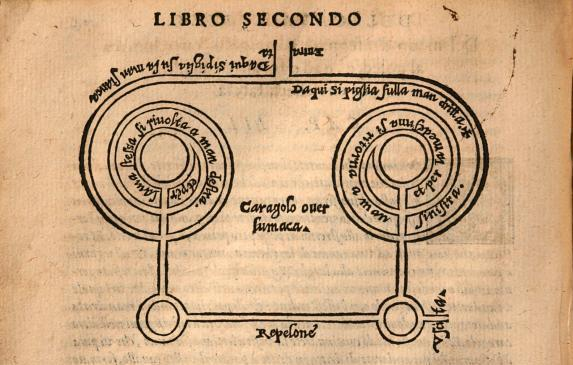Simple movements
Turning
“... you shall there turn in that sort we have heretofore prescribed, ever taking heed, that in turning, the contrary leg of the horse do come over the other: as for example. If you turn on the right hand, see that his left leg may go before and cover the right leg: and turning on the left hand, the right leg of the horse must do the like.” (Corte, p. 42)
Turning on the right hand. Note the left front leg crossing over the right front.
(PC: Author on Paddington Bear)
Ciambetta
Grisone, 1550. Tourni. The horse makes two circles (voltes) to the right, then two to the left, after which the horse proceeds in a straight line at either the trot or canter. At the end of the line, the horse performs a “raddoppio” (also called doubling, or modernly, a pirouette).
“And not that in turning diverse things are to be observed. First that he brings the contrary leg upon the other, and that he carry his legs neither too high, nor too low, also that he keep always one path, and that he neither presses forward, nor yet reel back in his turning, also that he keep his body in one stay, writhing neither head, neck, nor any part of his body, but to come in whole and round together, and close his turn in so narrow a row as may be.”
|
Corte, 1573. Tourni. The horse starts on a straight path, then makes three circles with a diameter of 8-12 meters each. The horse then returns to the path going the opposite direction, then makes three smaller circles of about 2-3 meters in diameter.
“... you shall there turn in that sort we have heretofore prescribed, ever taking heed, that in turning, the contrary leg of the horse do come over the other: as for example. If you turn on the right hand, see that his left leg may go before and cover the right leg: and turning on the left hand, the right leg of the horse must do the like.” (Corte, p. 42)
|
Fiaschi, 1556, maneggi di mezzo tempo. After going in a straight line, the horse performs a pesade and turns on his hind legs in a half pirouette.
Fiaschi, 1556, maneggio di una volta e mezza (a volte and a half). After going in a straight line, the horse performs a pirouette and a half, then returns to the track.
Fiaschi, 1556, volta d’anche (volte of the haunches). After going in a straight line, the horse performs a turn on the forehand.
De la Broue, 1602. “For the right hand. D is the first line, E is the second line. A demi-volte starts at B, then finish at F and continue with the passade to G.” (trans. Jobst)

De la Broue, 1602. “For the left hand. A, passade. B, take and make the aforementioned volte of one track at the trot. C, track of abovementioned passege, made with the front feet. D, track of the hind feet on the aforementioned passege.” (trans. Jobst)
.
Corte, 1573. Caragolo (snail). The horse performs a spiral, then a short straightaway, then a spiral in the other direction.
Corte, 1573. Esse serrato. The horse performs a figure eight with a volte at the top of each loop.
Corte, 1573. Serpeggiare. The horse performs a serpentine with a tourni at each end.
The Bias
De la Broue, 1602. “By the line of the letter A , one can judge what is straight, and this must be maintained without the horse bending the body or the neck. Track B represents the track that must be taken first by the right front foot. And the line of C shows the track of the hind foot.” (trans. Jobst)
PC: Author on Paddington Bear
PC: Author on Paddington Bear
Going Aside

De la Broue, 1602. “A is the line of the wall, B is the line of track of the front feet, and C is the line of the track of the back feet.” (trans. Jobst)
PC: Author on Paddington Bear
De le Broue, 1602.”To finish the first figure, make one more quarter, similar to the others.” (trans. Jobst)








Thank you for posting some of your research and translations!
ReplyDelete